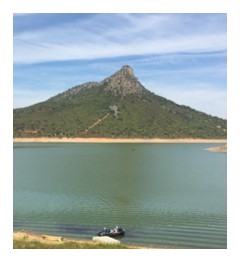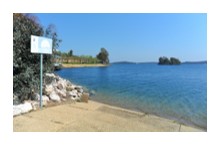Siberia Extremeña
This region has a lot of contrasts with low temperatures in winter and high temperatures in summer. The mountains dressed in an invaluable nature, freshwater beaches awarded with blue flag, fishing and hunting areas, bird watching areas or municipalities with architecture worthy of admiration give this environment a special charm that encourages every traveler to visit it at different times of the year.
 The region has five large swamps where the aforementioned blue flag beaches are located. Three of them in the course of the Guadiana River (Cíjara, García de Sola and Orellana) and the other two in the Zújar River (Embalse del Zújar and La Serena). Together they add 12% of the total water reservoir in Spain where one lives based on the barbel, pike, fang or gambusia.
The region has five large swamps where the aforementioned blue flag beaches are located. Three of them in the course of the Guadiana River (Cíjara, García de Sola and Orellana) and the other two in the Zújar River (Embalse del Zújar and La Serena). Together they add 12% of the total water reservoir in Spain where one lives based on the barbel, pike, fang or gambusia.
The Siberia Extremeña, divided into two associations, is currently composed of seventeen towns plus three annexes: Baterno, Casas de Don Pedro, Castilblanco, Esparragosa de Lares -with its annex Galizuela-, Fuenlabrada de los Montes, Garbayuela, Garlitos, Fern de los Montes-with Bohonal de los Montes-, Herrera del Duque -con Peloche-, Puebla de Alcocer, El Risco, Sancti-Spiritus, Siruela, Talarrubias, Tamurejo, Valdecaballeros and Villarta de los Montes. It has an extension of 2,756.26 square kilometers and 19,820 inhabitants, who more than a third work in the services sector (36.38%) and 31.03% in agriculture, unlike the 90% that did so at the end from the 19th century.
Its geographical position between the Castilian plateau (continental climate), the Atlantic Sea (milder climate) and the Mediterranean Sea (warmer and much drier) makes this territory a transition strip with a total of between 60 and 70 rainy days a year and an average temperature around 16 ° C (January being the coldest month with 6-7 ° C on average and July the warmest with 25-27 ° C.
The ecosystem that can be found in the mountains and hiking trails in the area is the Mediterranean forest in which the oak, cork oak, quejigo, madroño, durillo or myrtle predominate. In these trees you can find birds such as the griffon vulture, the Iberian imperial eagles, the peregrine falcon or the eagle owl. And among the hunting fauna you can highlight the presence of wild boars, deer, red partridges or rabbits.
Beaches
 The Siberia Extremeña is the largest extension on the internal coast thanks to its five surrounding swamps and its two main rivers: Guadiana and Zújar.
The Siberia Extremeña is the largest extension on the internal coast thanks to its five surrounding swamps and its two main rivers: Guadiana and Zújar.
Nearby is the blue flag of Orellana la Vieja, but there are others on the way to being like the Playa de Esparragosa de Lares.
